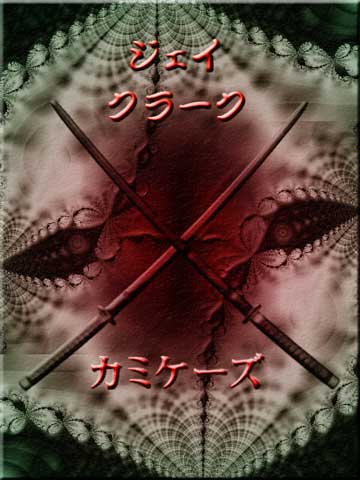Slade's Morgue:
Kamikaze

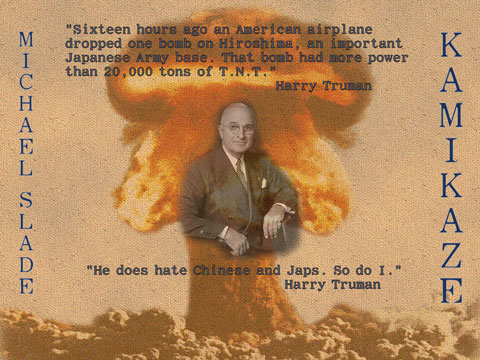

Canadian edition of KAMIKAZE
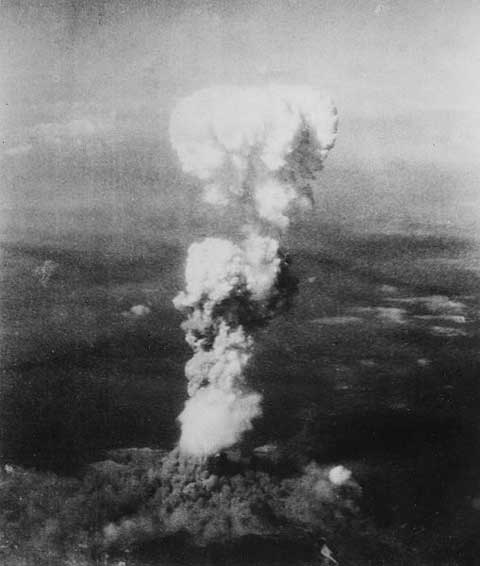
August 6, 1945
Little Boy atomic bomb explodes over Hiroshima

August 9, 1945
Fat Man atomic bomb explodes over Nagasaki
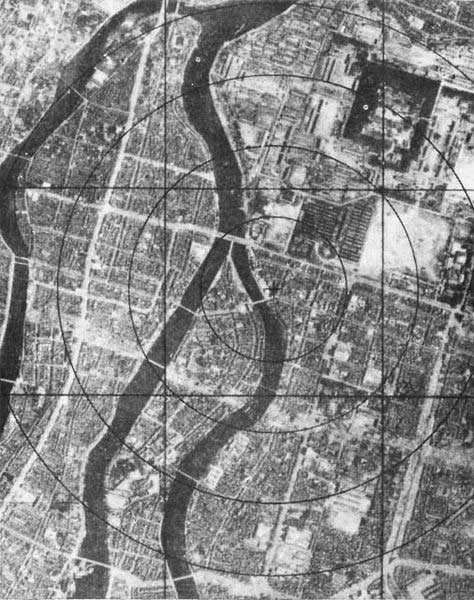
Hiroshima before the bombing

Hiroshima after the bombing

Atomic bomb cataract from viewing the explosion

Genjo Tokuda's extended family after Hiroshima's bombing
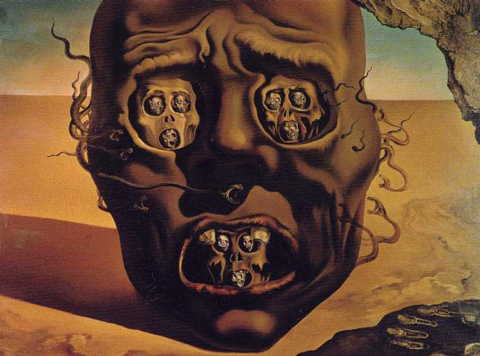
Salvador Dali's THE FACE OF WAR (1940)

American edition of KAMIKAZE
Vengeance is his...
Genjo Tokuda - a Hiroshima survivor and head of the yakuza crime syndicate - is lured to Vancouver for the Pacific War Vets Convention. The keynote speaker will be one of the crewmen of the Enola Gay, the plane that dropped the atomic bomb on Hiroshima, killing Tokuda's entire family.
Tokuda plans to satisfy the bushido oath he made to his ancestors years ago at the ruins of their Hiroshima shrine. First he'll kill the crewman's family; then he'll kill the American airman in a fittingly gruesome way. That crewman is the grandfather of Corporal Jackie Hett of the RCMP's Special X squad. Special X will have to stop a killer before he hits too close to home.
KAMIKAZE - the companion novel to SWASTIKA - is Michael Slade's World War II revenge thriller. Here's the story behind it.
In January 2003, Slade's mother collapsed in her home. Her first words to him at the hospital were "Is this the beginning of the end?" It was. Four months later, she succumbed to pancreatic cancer.
Who we are individually depends on our personal life stories and the stories of our ancestors. Slade spent those precious last months at his mother's bedside, learning everything she could tell him about the past.
Because Slade's Dad saw action at WWII turning points on the Atlantic, in Europe, and in North Africa (see CRUCIFIED and SWASTIKA), his wartime experiences overshadowed Slade's Mom's. She nursed the wounded on the shore of the Pacific theater, and one day - under the effect of morphine - said from her deathbed, "If I'd been older, I might've been at St. Stephen's in Hong Kong."
Slade went home and Googled it.

Slade's favorite photo of his Mom as a tomboy
Vivian Murdoch was the granddaughter of the pioneer who founded Calgary. He lived among the Blackfoot outside the walls of the Mounted Police fort, and was known to them as the Leather Man (see BIO). Vivian grew up in a rural community of 500, with dreams of seeking adventure around the world.
In her late teens, she went to the big city - Edmonton - and from 1941 to 1944, trained in residence as a nurse here:
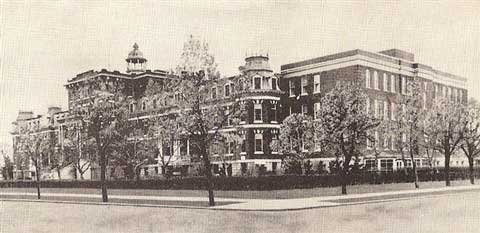
Now that's a hospital

"You've come a long way, baby..."
Slade's Mom graduating in 1944

...And still have a long way to go.
Slade's Mom gets her RN in 1944
The day she got her RN (Registered Nurse), Viv hopped a train through the Rockies, heading for Vancouver. On arriving, she found a room in a boarding house, and phoned her name into the General Hospital for a fill-in job. Then off she ventured to sightsee Stanley Park.

Slade's Mom sitting on the Seawall in Stanley Park on the day she arrived
On returning to the boarding house, Viv learned she was called in to work that night. It was a two-mile walk to the hospital. Her room wasn't on the tram route, gas was rationed and few people drove cars, the city was under a blackout, and rapists picked off women in the dark.
Viv had a long trek alone in her nurse's whites.
The landlady was a no-nonsense woman. She handed Viv a baseball bat and gave her sound advice. "Follow the white line down the center of the road. If you hear footsteps coming for you, they mean you no good. Swing the bat like hell and knock his head out of the park."
So that's how Viv went to work each night.
Vancouver was exciting, but not exciting enough.
Slade's Mom jumped at the chance to go nurse "in the Land of the Head Hunters."
IN THE LAND OF THE HEAD HUNTERS (1914)
The Kwakiutl dance is to Baxbakualanuxsiwae, He-who-is-first-to-eat-Man-at-the-mouth-of-the-river

Alert Bay in 1944


Kwakiutl Territory
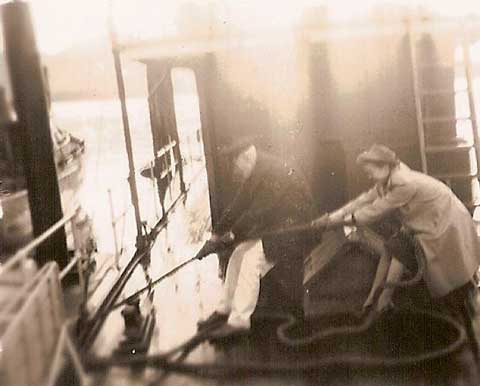
Viv working the boat enroute to Alert Bay

Alert Bay in 1944
Hospital on the far right
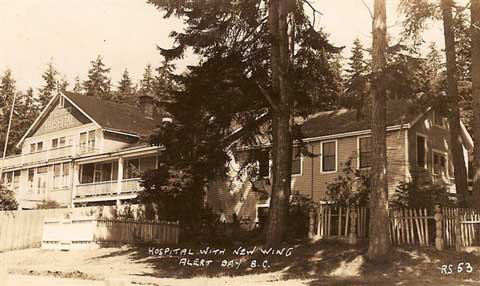
Alert Bay hospital, 1944
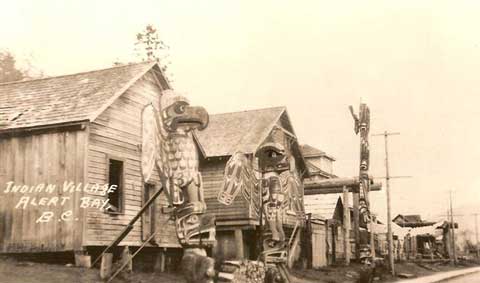
Kwakiutl village
Note the washing on the line
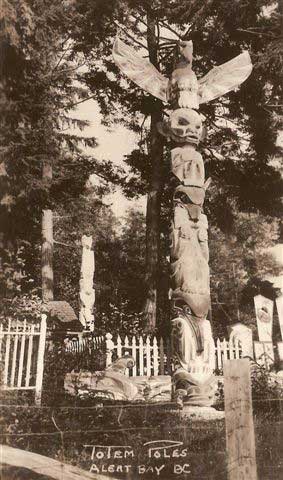
These totems aren't for tourists
They're the real thing

Alert Bay totems
Slade's Mom took this photo of Kwakiutl kids playing on the street. Note how the totem is part of the community:

Slade's Mom also took this photo of the Kwakiutl chief with the tribal totem. The chief's son carved her a magnificent pair of bracelets.

Vivian Murdoch was a traditionalist. Her family tree was traced back to the 1600s in Scotland. Her grandfather, the Leather Man, had pitched his tent among the Blackfoot and had learned their language. In his old age, when he was crippled, the Blackfoot came to him. They'd sit on the porch and talk about how things used to be.
The residential school system is a blight on Canada's history. It sought to erase Native culture and turn Native kids into whites. Slade's Mom did not like that one bit. Why should she know where she came from and grasp her ancestors' traditions, but they couldn't?
It's from his Mom that Slade inherited a lifelong fascination with the Plains and totem tribes (see HEADHUNTER, CUTTHROAT, and PRIMAL SCREAM). And of all the totem tribes, Slade finds the Kwakiutl the most riveting. IN THE LAND OF THE HEAD HUNTERS and cannibals? That's fact, not fiction.
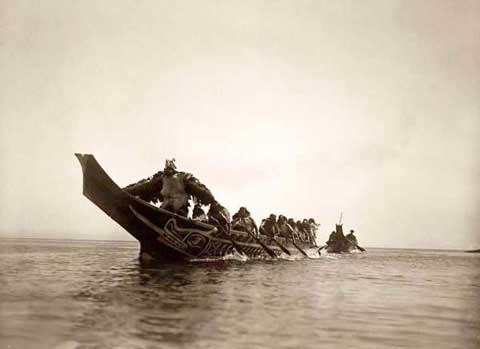
Kwakiutl canoe

Kwakiutl chief

Kwakiutl warrior
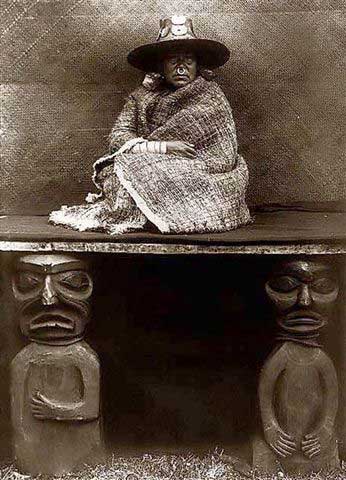
Kwakiutl woman
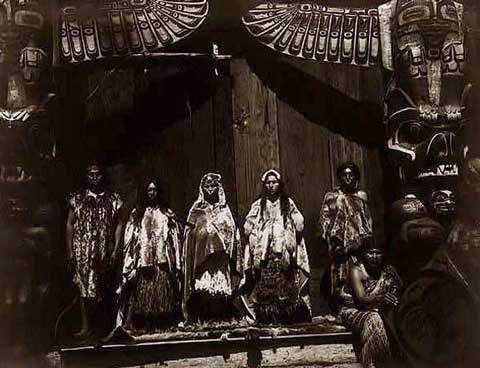
Kwakiutl wedding

Cannibal god dancers (see video above)

Kwakiutl wolf dancer

Dancing to restore the eclipsed moon

Preparing for the Winter Dance

Winter dancers

Winter Dance fool devoted to filth and disorder
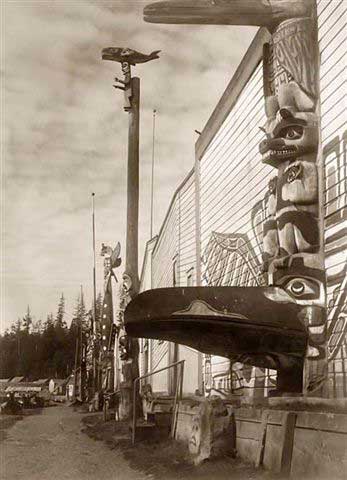
Alert Bay totems in 1914 (see the later image above)
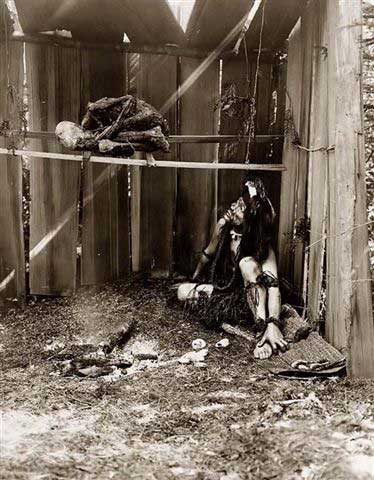
Drying a Kwakiutl mummy

Cradling a Kwakiutl mummy

Shaman of the Hamatsa cannibal cult

Hamatsa

Hamatsa
Headhunter? Look what's strung around his neck
Cannibal? Look what he's holding
Slade's Mom went looking for adventure, and she found it. Those photos by Edward S. Curtis were taken in 1914, just 30 years before Viv nursed in Alert Bay. The 22-year-old was immersed in an ancient culture that went back thousands of years, with powerful underground beliefs. The potlatch was banned by whites in 1913.
So there were hidden dangers.
An old Kwakiutl woman suffering mental problems was brought to the hospital. Alert Bay wasn't incorporated as a B.C. village until 1946, two years after Viv arrived. Whites didn't settle there until 1870. So the troubled old woman went back to the active days of the Hamatsa cannibal cult. Her psychosis involved Baxbakualanuxsiwae. She thought the cannibal god crests on the totems were trying to eat her.
The hospital's doctor decided to send the old woman down to Essondale, the mental asylum near Vancouver, for assessment. The police boat was summoned, and Viv was to escort her.
In the 1940s, everyone wore hats. Slade's Mom is wearing a hat in every photo above, even as a tomboy with the pigs. So are most of the Kwakiutl Natives. The old woman had a fancy wicker-woven hat festooned with flowers (see "Kwakiutl woman" above).
If you escort a patient or prisoner and there are bunk beds, the custodian always takes the lower bunk. Should the patient or prisoner move in the night, the custodian can hear the squeaking springs. But this was Viv's first escort, and she made a mistake.
Because the boat was a police boat, there was a cop onboard. It was a long cruise to Vancouver, and what better way to pass time than by trying to chat up the nurse in the hold? So down he went to find the cabin door ajar for air, and rushed in not a moment too soon to grab the old woman's arm.
Hidden in her flowered hat was a long hatpin. With Viv nodding off in the top bunk, the patient had crept out of bed to get the stiletto, and was about to stab her in the heart.
If not for that cop, there'd be no Slade books to read.

See the eyes?

Rising Sun
In the autumn of 1941 - just weeks before the surprise attack on Pearl Harbor - the British government accepted an offer by the Canadian government to send two infantry battalions and a brigade headquarters (1,975 personnel) to reinforce the Hong Kong garrison. The troops arrived on two ships on November 16.

Canadian soldiers arrive in Hong Kong

Canadians defending Hong Kong's Gin Drinkers' Line
When Canada entered World War II in 1939, the young men in Viv's home town went off to fight. A photo of every warrior went up in the grocery store window, and if he got killed, a black banner crossed one corner of his picture. Because most were in for the war's six-year duration, almost half were dead by 1945.
Had Viv had the chance to go to Hong Kong with the reinforcements, do you think she'd have gone? What an adventure! Plus, she could do her bit.
The question every author hears is, "Where do you get your ideas?" The idea for KAMIKAZE came from Slade's Mom's deathbed comment: "If I'd been older, I might've been at St. Stephen's in Hong Kong." For the nurse in the novel, Slade rolled the clock back three years and put his Mom's fictional counterpart there.
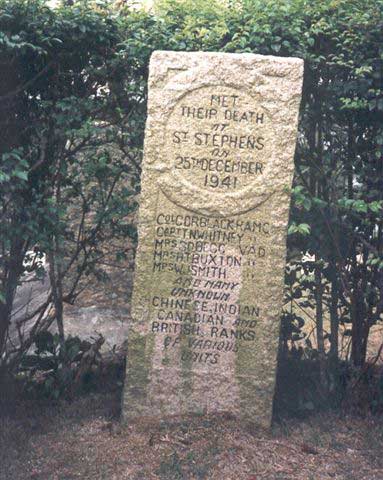
St Stephen's memorial stone
Note the "Canadian" ranks
KAMIKAZE opens at Pearl Harbor, Hawaii, on December 7, 1941.

Pearl Harbor attack from a Japanese cockpit
Note the plane over Battleship Row

See the oil slick and ripples from the first hit? Torpedos in the water? Hickam Field air base smoking in the distance?
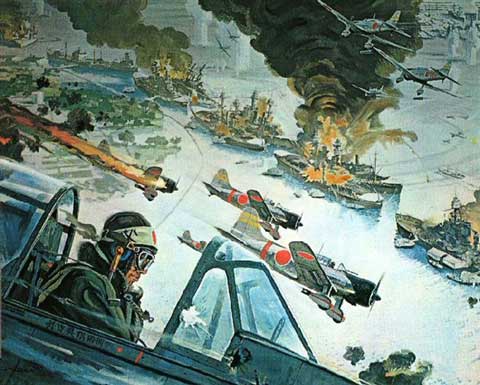
TORA! TORA! TORA! promotion poster
Attack on Battleship Row
Artwork by Robert McCall
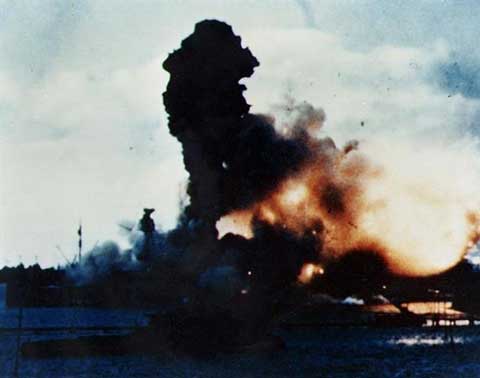
USS Arizona explodes
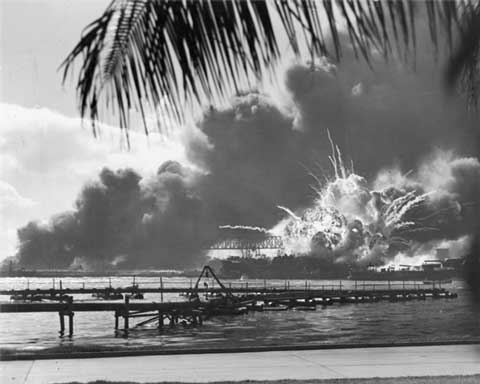
USS Shaw explodes
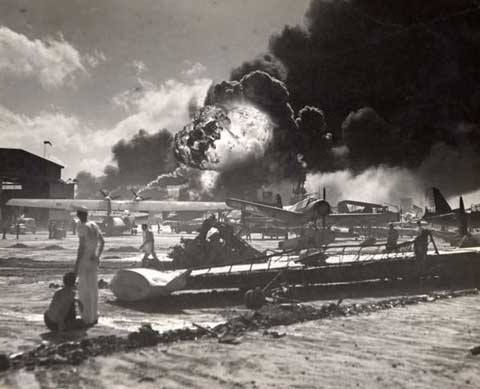
View from Ford Island airfield
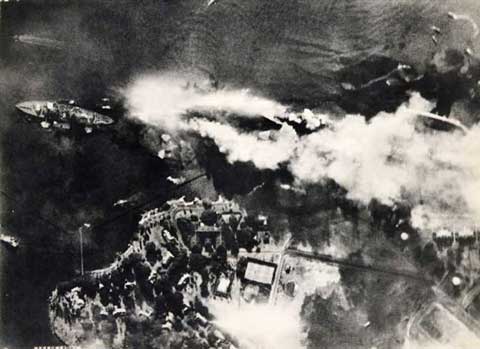
Battleship Row devastated


Pearl Harbor layout in October 1941
Ford Island (center) with Battleship Row on its left
Hickam Field air base top center-left
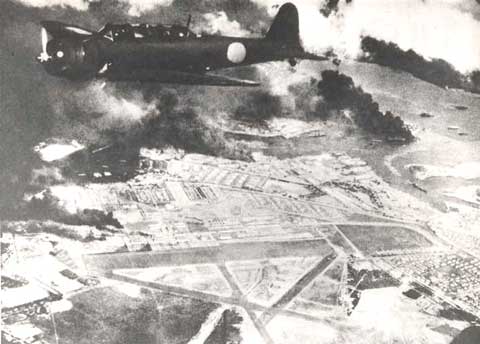
Japanese bomber over Hickam Field
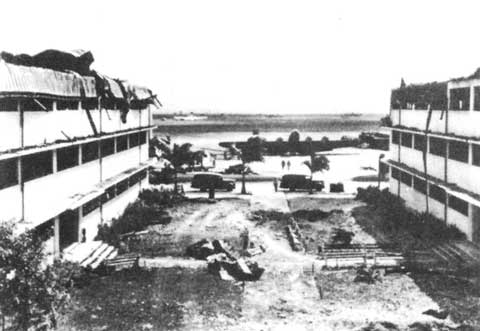
Barracks at Hickam Field
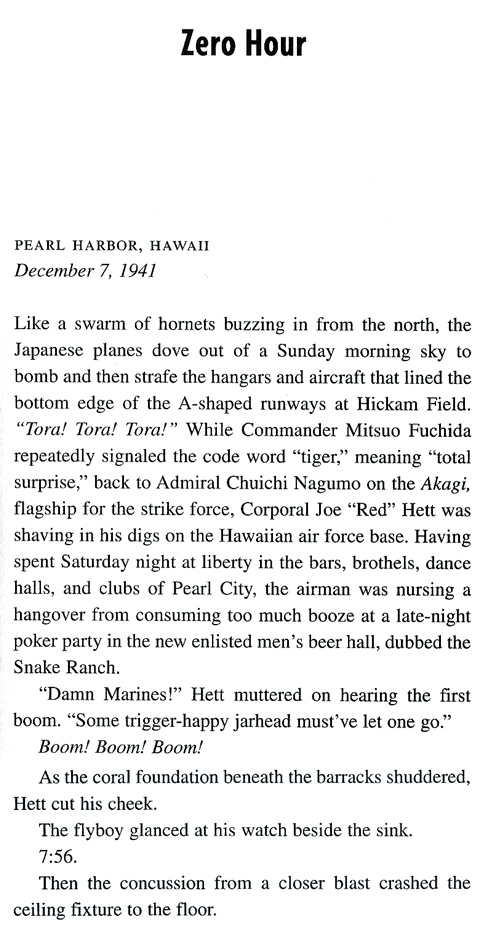
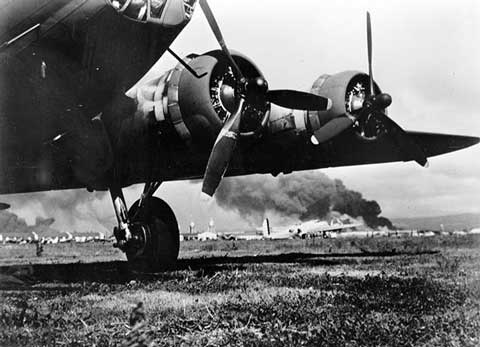
Attack on Hickam Field
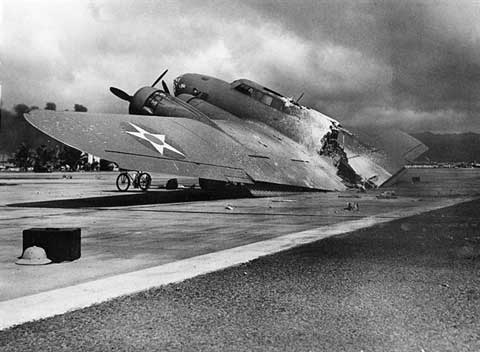

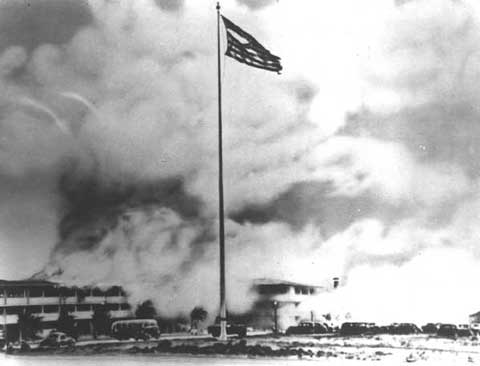
Tattered Old Glory
This photo of Hickam's flag looks posed. It's not. Three and a half years later, when Japan surrendered on August 14, 1945, the same flag flew over the White House.

TORA! TORA! TORA! promotion poster
Attack on Hickam Field
Artwork by Robert McCall

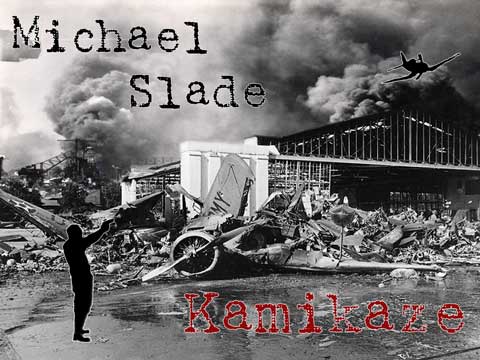
Less than eight hours after the attack on Pearl Harbor, 52,000 battle-hardened Japanese troops stormed Hong Kong. Outnumbered more than 3 to 1, most of the 14,000 defenders had never seen action. After eighteen days of combat, the British colony fell on Christmas Day.
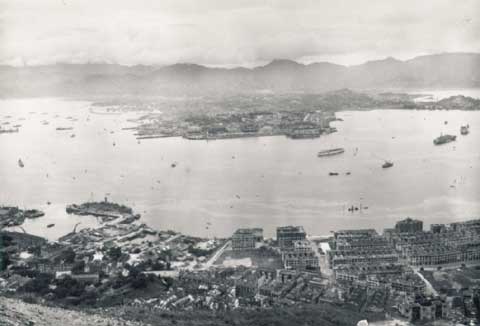
Hong Kong in the 1940s, viewed from the Peak
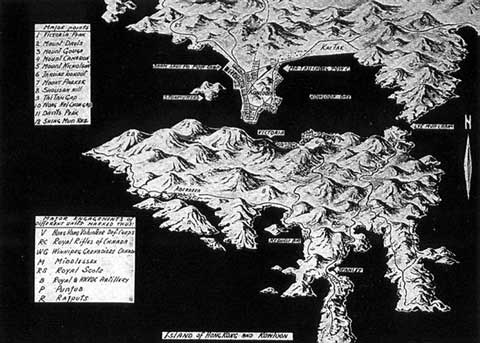
Battle of Hong Kong engagements
Note Stanley Peninsula at the bottom

Japanese troops march on Hong Kong

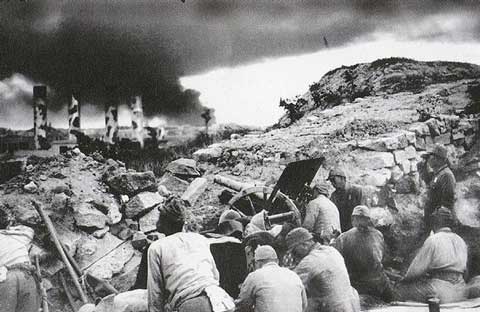
The Japanese army attacks

The Battle of Hong Kong by Japanese war artist Hoshum Yamaguchi

Attacking the Wong Nei Chong Gap by Japanese war artist Koiso Yoshihira
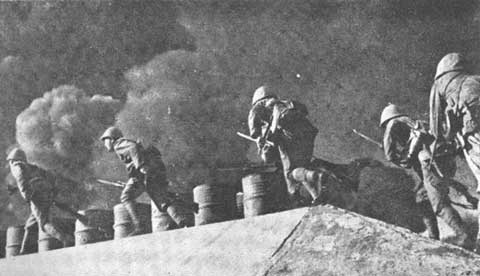
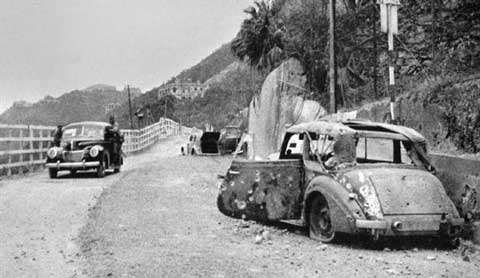
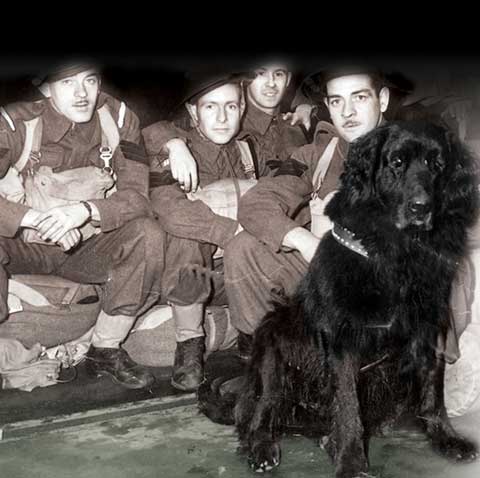
Royal Rifles with "Gander"
Conspicuous courage in combat creates immortal heroes. So here's a good story.
Before shipping out to Hong Kong in 1941, the Royal Rifles were stationed at Gander in Newfoundland, Canada. The massive Newfoundland dog above was a family pet named Pal. In an exuberant greeting, Pal accidentally scratched a child's face with his paw. Afraid the dog would be put down, his owner offered him to the soldiers as a mascot.
Gander - his new name - was promoted to sergeant. Stripes were attached to his collar. The dog accompanied the Royal Rifles to Hong Kong, and lazed for a few weeks on a shady verandah.
During the Japanese attack, Gander showed no fear of guns or bombs. He attacked the enemy on the beach, and later, in the night, to protect a group of wounded soldiers. In the desperate fight for Lye Mun Gap, a grenade got tossed in among the defenders. Gander gripped it in his jaws, and ran toward the attackers.
The grenade exploded, killing him in action.
"For saving the lives of Canadian infantrymen during the Battle of Lye Mun on Hong Kong Island in December, 1941," Gander was posthumously awarded the Dickin Medal in 2000. The first such award since 1949, it's now on permanent display in the Canadian War Museum.
In 2009, Canada unveiled the Hong Kong Veterans Memorial Wall in Ottawa, a few blocks from Parliament Hill. If you look closely, you'll see - at the veterans' insistence - that Gander's name is etched among the 1,975 Canadian defenders of the Far East garrison.
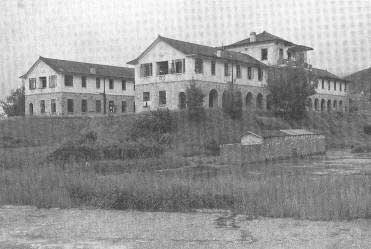
St. Stephen's Hospital
St. Stephen's College on the Stanley Peninsula served as a Red Cross hospital for about 100 wounded soldiers. At dawn on Christmas morning, it was surrounded by 200 Japanese troops drunk on looted liquor. When the doctor in charge waved a white sheet of surrender at the door, he was shot in the head. The doctor's body was bayoneted as each attacker entered.
Running amok through the hospital, the intruders stabbed 56 British and Canadian patients to death in their beds.
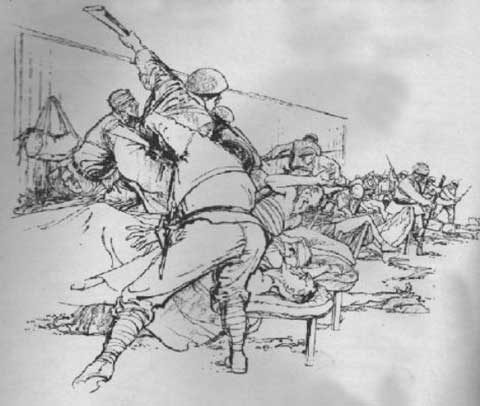
The St. Stephen's Massacre
The survivors were caged in two rooms on the second floor. Eight nurses in one room, and 50-some men in the other. As morning wore on, the temperature climbed to 120 degrees. The men were removed in pairs and hacked apart alive with swords in a torture room.
Later, four prisoners were forced to watch the mutilations. They were released to go to Fort Stanley and report what they'd seen. If Hong Kong didn't surrender, all would die like that. The British colony surrendered that afternoon.
As for the eight nurses, they were dragged out one by one and gang-raped on the bed of corpses. Then they, too, were butchered.
All but one in KAMIKAZE.
Genjo Tokuda saves Viv Barrow for himself.
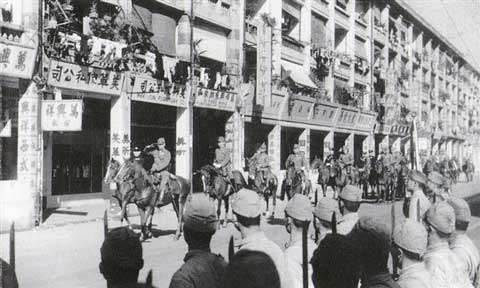
Japanese victory parade
On December 26, the Japanese held a victory parade on Queen's Road in Hong Kong. That same day, the bodies at St. Stephen's Hospital were burned on a pyre. The commander taking the salute in the photo above is Lieutenant General Takashi Sakai.
In 1946, Sakai was tried for war crimes, including St. Stephen's, and shot by a firing squad.
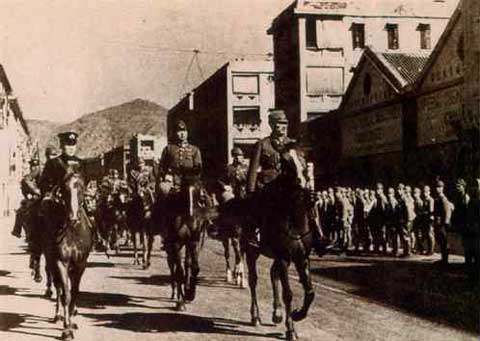
From "Black Christmas" on, St. Stephen's College was part of Stanley Internment Camp. The camp held non-military prisoners of war.
If a woman has sex with two men in a short interval of time, she can give birth to non-identical twins with different fathers.
During the St. Stephen's Massacre, Genjo Tokuda bayonets Viv Barrow's lover to death. Nine months after the war crime - when Tokuda has pressed on to other Japanese conquests - Viv Barrow gives birth to her lover's daughter and Genjo Tokuda's son at Stanley Internment Camp.
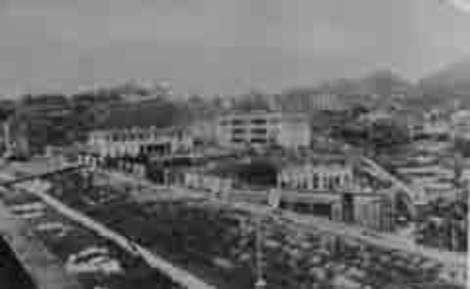
Stanley Internment Camp
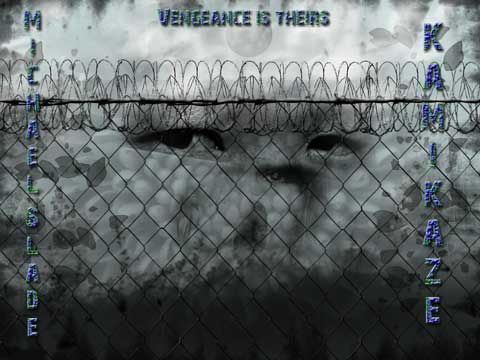
Every Slade novel is a "What if...?" thriller. What if Vivian Murdoch had been three years older? What if her quest for adventure had taken her to Hong Kong? And what if she'd pitched in to nurse the wounded Canadian soldiers at St. Stephen's on Christmas Day?
By 1945, Slade's soon-to-be Mom had nursed on the land and on the sea, so she applied for a job to nurse in the air. In the early days of Canadian commercial aviation, all "stewardesses" were nurses, for there were a lot more health hazards in non-pressurized prop planes like the Lockheed Lodestar.
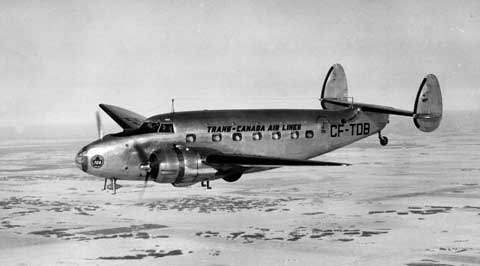
TCA (now Air Canada) Lodestar
Stewardesses endured cabin hazards of their own. War rationing meant skirts were short. The airline dress code put them in high heels. The wing spar of the Lodestar passed through the cabin, forcing the stewardess to step over it repeatedly in flight. Businessmen seated behind the spar prayed for turbulence.
One of Viv's tasks on every flight was to collect these forms:

On July 29, 1945 - eight days before the atomic bomb obliterated Hiroshima - Viv collected a form that read: "I'm having a swell time up here; have a good job; a good future; know a lot of nice people; and think your airline is wonderful, Mr. English. But HOW I wish your beautiful stewardess Vivian Murdoch would be my wife!!!! - !! Viv, I love you, & know this is one hell of a way to propose marriage. But I know you'll like it this way - while flying 'our' route together. Be Mrs. Clarke for me - ?? Your everloving Jack."
From September 1940 to January 1945, Flight Lieutenant Jack Clarke had "done his bit" for the war. For his 47 combat missions and V-2 rocket attack, see SWASTIKA and CRUCIFIED. Though still in the RCAF, he was on loan from the air force to pilot Trans-Canada Airlines.
Viv said, "Yes," and married him that November.

Before the war, Jack was a commercial artist with Associated Screen News in Montreal. Here's the Christmas card he designed for 1946. Viv and Jack in the Lodestar. You'll note he's winking.
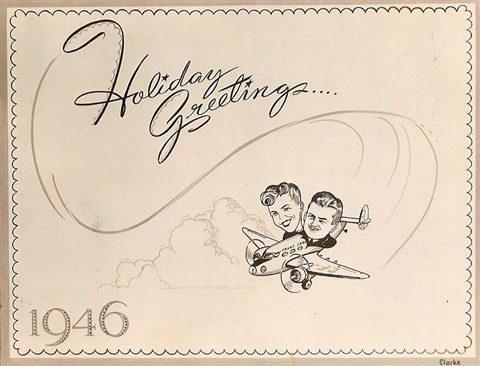
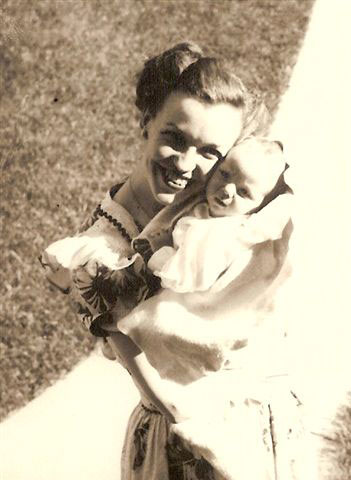
Slade and his Mom
Remember this image for "full circle" below
For 1947, Slade's Dad redesigned the Christmas card.
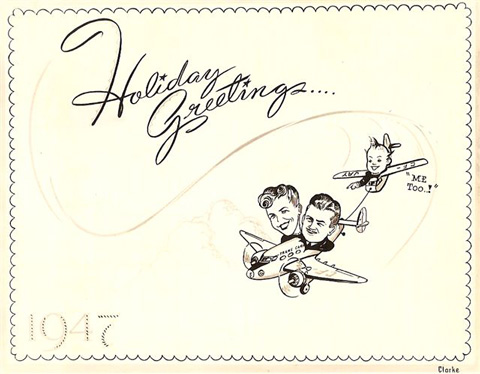
The Lodestar, with Slade in tow
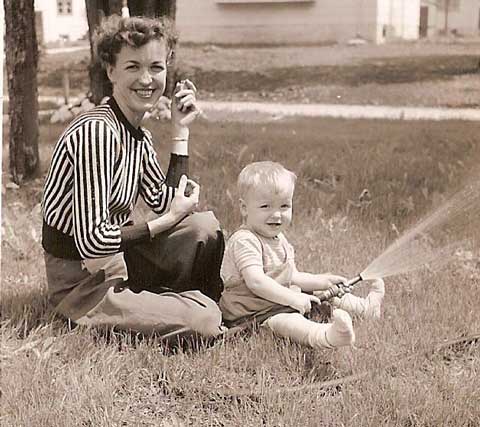
The Summer of 1948
No son ever had a better mother than Slade's. Viv was something else. She loved life. Every day was a new adventure with her. The circus. The Santa Claus parade. The dinosaur park. The Calgary Stampede. The Coca-Cola factory. Plays, movies, concerts...and on and on it went.
In December 1956, disaster struck. In one of the worst winter storms on record, Jack's DC-4 lost an engine and its guidance beacon during heavy icing and downdraft conditions in the Cascade Mountains, "the Graveyard of the Air." Flying blind and losing altitude, his plane slammed into Mount Slesse.
In this photo taken in 1994, the light patch on the center peak is where the North Star hit.

Losing the love of her life broke Viv's heart. But she had a job to do: raising Jack's son. The two had a pass on the airline. Anywhere it flew. So Viv took Slade to Disneyland, when it was brand-new; and to New York, where they lucked into meeting Jack Dempsey, the Heavyweight Champ of the World (see BLOG); and to London, for Madame Tussaud's Chamber of Horrors and Jack the Ripper's haunts; and to the Caribbean, for a pirate adventure complete with Sam Lord's Castle; and to countless other places.
To spark his imagination, Viv indulged Slade's penchant for mystery and the macabre. She took him to the scary movies that required an adult. He could stay up past midnight in the school week for Boris Karloff's THRILLER. On Halloween, they ghost-toured spooky real-life murder sites.
The summer of 1966 saw Slade in a dull job. On a scorching day, he came home and spun the globe in his room. Closing his eyes, he swore to himself, "Wherever my finger points, that's where I'll be next summer." He opened his eyes to find his finger in the Soviet Union.
The Cold War was on, and the Cuban Missile Crisis - the brink of H-bomb annihilation - was just four years in the past. The only way into Russia was by train. Airline links came later. It took Slade months to get the necessary visas. First for Russia, then Poland, then Czechoslovakia.
Everyone had a reason why Viv should dissuade Slade. "If something goes wrong, he'll never get out." "The Americans are so anti-Communist that they'll shut the border to him." "The Middle East is heating up, and Russia supports the Arabs." (As it turned out, that reason was sound. The Six-Day War was fought while Slade was in Moscow, Kiev, and Leningrad.)
Viv's reply? "At his age, his Dad was flying bombers over Nazi Germany."
Slade came out of repressed Russia into the Summer of Love. Sex, drugs, and rock-n-roll. What a wild time to backpack around Europe that was! In the fall, he returned to university. His major? History and Strategic Politics. His focus? WWII and the Cold War.
The Vietnam War was raging, and the campus was in turmoil. It was a long, rainy walk in from the parking lot. Across the tented roof covering a thousand bicycle stalls, BOMB THE CONG! was painted in huge white letters. On the plaza in front of the library, American draft dodgers held pot-fueled rallies: "One, two, three, four, we don't want your fuckin' war..."
Strategic Studies was a high-voltage class. So A-type personality was its powerhouse professor that he later dropped dead from a heart attack in his early thirties. The moment he entered the room, your eyes locked on him and never let go. "Who's got a cigarette?" A student complied. "Leave the pack on my desk." The prof chain-smoked as he paced, lighting the next cigarette off the butt of the last one. "In this course, you're going to take a year to write a single essay. It will count for 60% of your mark. And I'm going to tear your thinking to pieces.
"No secondary sources will be allowed. I don't give a damn what some outsider thinks. You will restrict your research to the players involved. And you will remember that every politician lies to put on a good face. What I expect you to do is to catch them in those lies. How? Cross reference."
Strolling the campus for hours, Slade tried to think of a topic deep enough to engross him for a year. As he walked in from the lot next day, the answer glared before him:
BOMB THE CONG!
140,000 Japanese were fried alive by the Little Boy atomic bomb dropped on Hiroshima. 80,000 Japanese by the Fat Man atomic bomb dropped on Nagasaki. Many more suffered horrendously from flash burns and radiation sickness. Most were civilians.
So, how does an ethical man decide to use a secret doomsday weapon on civilians without warning?

Slade's essay THE DECISION TO DROP THE BOMB AND THE SURRENDER OF JAPAN
KAMIKAZE is an action thriller, not a strategic study. However, Slade's father thought a book was a failure if you didn't come out knowing more than you did going in. The only person whose opinion really counts is Genjo Tokuda, the merciless godfather - kumicho - of the Tokyo yakuza. He has weighed the evidence with a very cold eye, and you - the reader - may watch it play out, to see if you agree.
A good way to get a feel for the spirit - the Zeitgeist - of any era is to look at its propaganda.

From the United States Office of War Information

Official U.S. poster
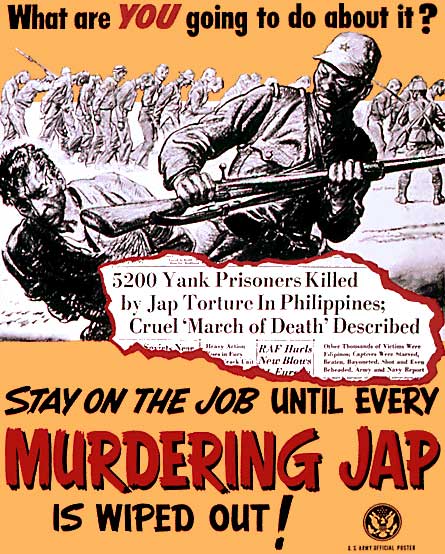
U.S. Army official poster
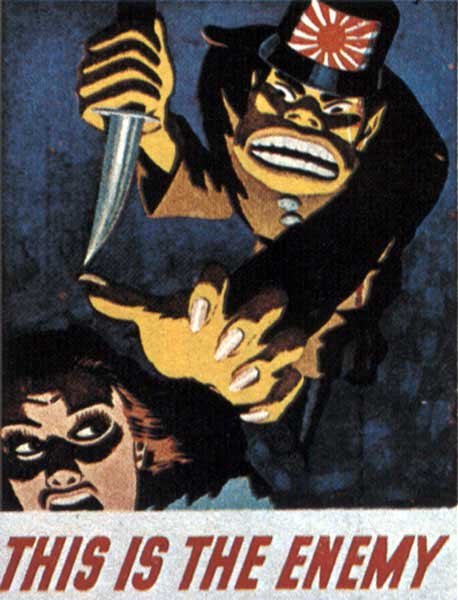
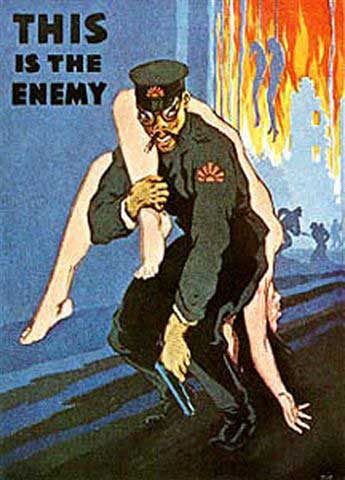

Official U.S. poster
Subtext: They're going to rape our women!
Note the thumb claw and fangs

U.S. Army official poster

Dr. Seuss

Rube Goldberg

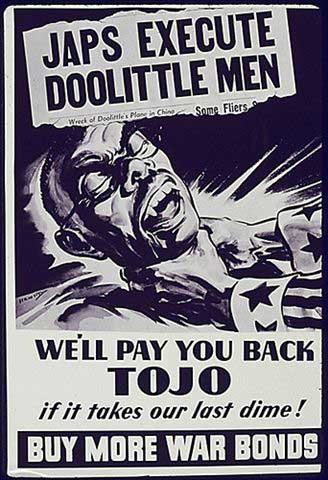
Treasury Department poster

Water torture

Disemboweling

Skinning

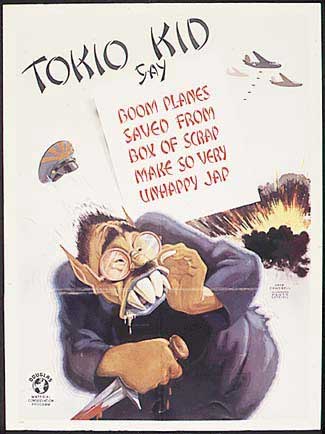
Official U.S. poster prepared for Douglas Aircraft
Note the ears, fangs, drool, and claws
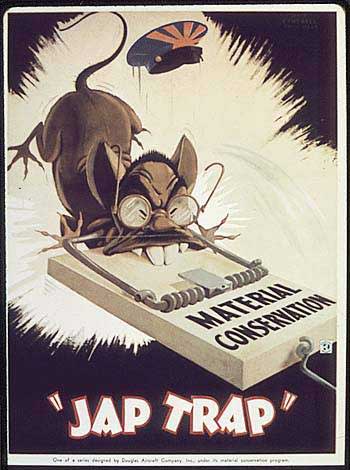
Douglas Aircraft

U.S. Army official poster
Genjo Tokuda has a different view of the war. His ancestors were samurai, nobles who follow "the way of the warrior" - bushido - going back a thousand years.


A samurai (1890) with his daisho swords
The large sword is the katana, the battlefield sword. That sword is the soul of his warriorship, so the samurai gives it a name. "Kamikaze" - Divine Wind - is the name of the sword that Genjo Tokuda's father gave him at their family shrine when his son went off to war.
Kamikaze is a "four body sword." It will slice through four men with a single slash.
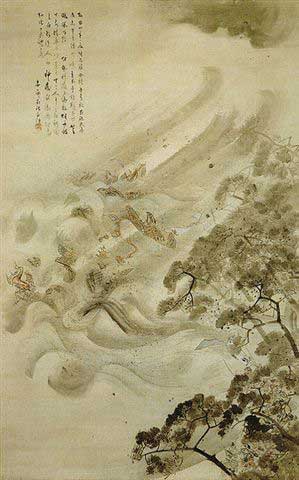
MONGOL INVASION by Kikuchi Yoosai, 1847
Divine Wind saved Japan from two Mongol invasions launched by Kublai Khan in the 1200s. Both fleets were destroyed by typhoons.
Toward the end of World War II, the Chrysanthemum Throne was threatened by another invasion. So Japan unleashed a human divine wind: kamikaze pilots called "floating chrysanthemums." Die to protect the emperor in the eyes of the deities and the spirits of your comrades, and you were a thundergod.
Americans called them "hell birds."
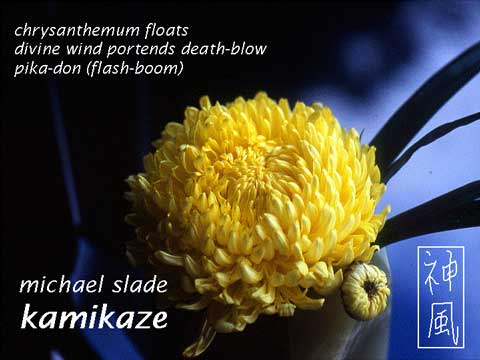
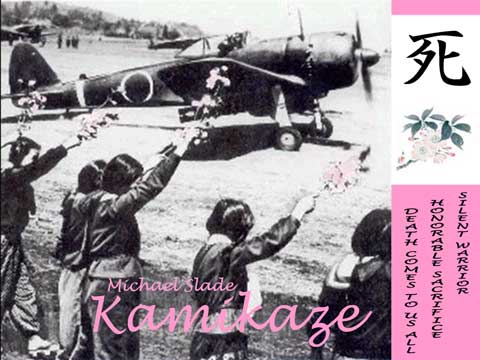
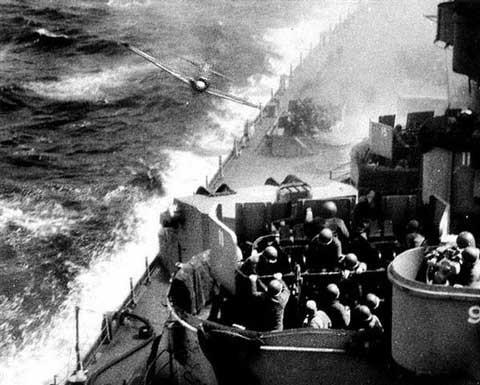
Kamikaze about to hit the USS Missouri off Okinawa
The remains of the pilot above were recovered onboard "Big Mo," the USS Missouri. The captain decided that the young Japanese kamikaze had done his duty to the best of his ability and with honor, so the following day, he was given a military funeral and buried at sea with honors.
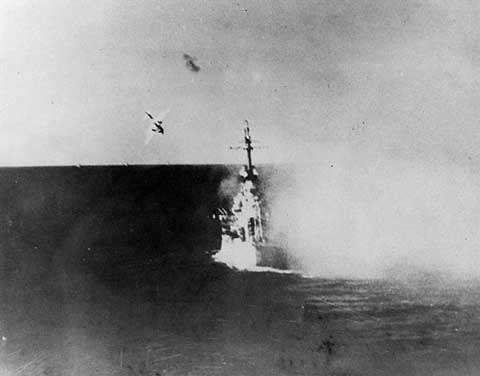
Kamikaze attacking the USS Columbia

The USS Columbia hit
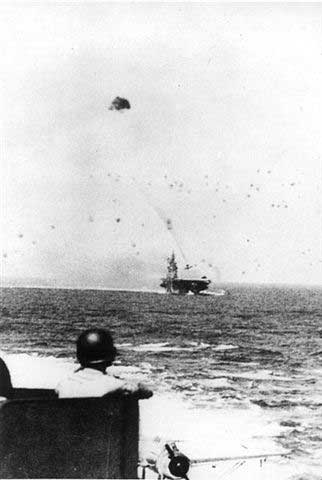
Kamikaze about to hit the USS Intrepid
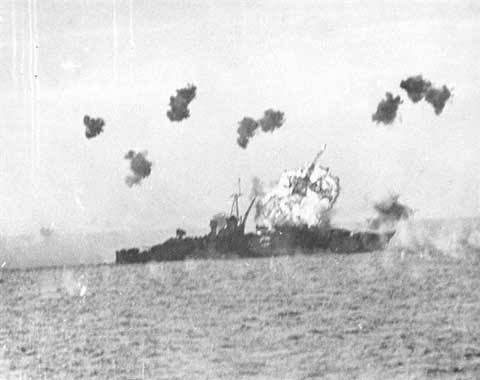
Anti-aircraft guns fail to stop the USS Louisville being hit
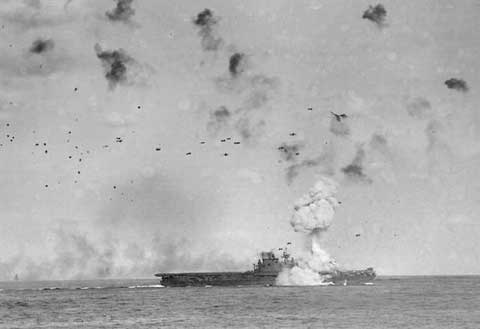
Anti-aircraft guns fail to stop the USS Enterprise being hit
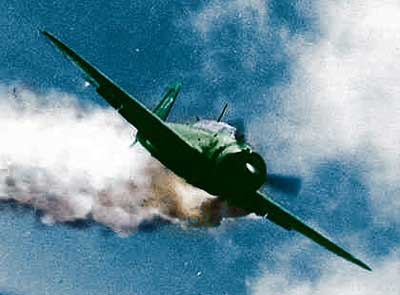
Kamikaze diving toward the USS Essex

The USS Essex hit

The USS Bunker Hill hit
Bushido demands loyalty and honor until death from all samurai. Suicide - instead of defeat, capture, or shame - was deeply entrenched in World War II Japanese military culture. Kamikaze pilots embraced that samurai tradition. As did soldiers who performed the ritual of seppuku (hara-kiri) "stomach-cutting."

Samurai perparing for seppuku
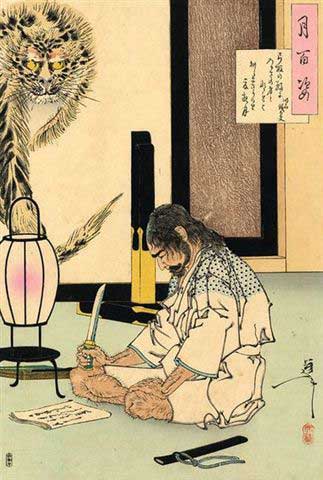
Drawing by Yoshitoshi Tsukioka, about 1890
Note the death poem on the floor
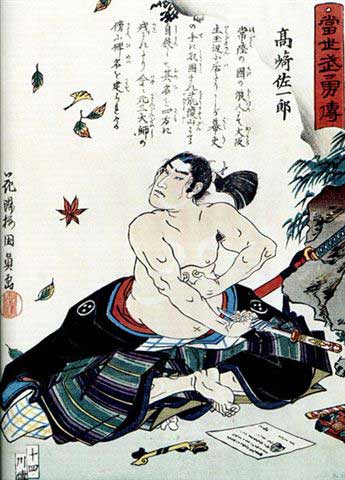
Drawing by Kunikazu Utagawa, about 1855
Again, note the death poem
Kamikaze attacks reached their peak at the Battle of Okinawa. Genjo Tokuda was there. When defeat was certain, the Japanese generals defending the island performed seppuku. So would have Tokuda had he not been knocked out and burned in a cave "blowing." When he came to, he was a prisoner of war.

Flamethrowing tank "blowing" a cave on Okinawa
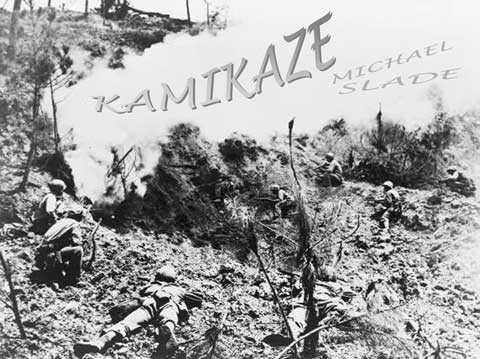
On August 6, 1945 - while Genjo Tokuda was in a POW camp - the Enola Gay B-29 bomber with Little Boy in its cargo bay took off for Hiroshima, Japan. The crew knew something big was up, but not what they were carrying. Only once the mission was past the point of no return did they first hear the words "atomic bomb."

Crew of the Enola Gay, minus Sgt. Joe "Red" Hett
"Avenge December 7!" "Avenge Pearl Harbor!" Sgt. Joe Hett got to do just that.
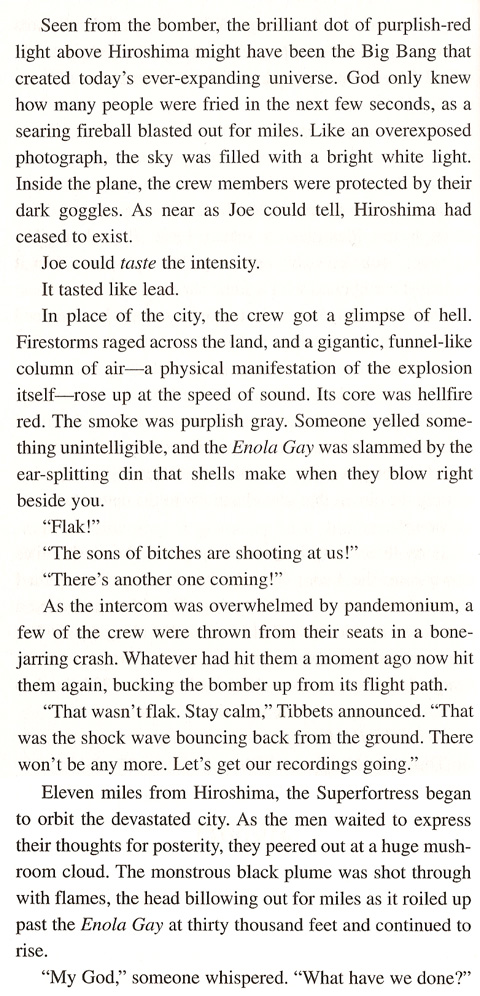
From 1945 on, Genjo Tokuda's obsession has been "Avenge Hiroshima!"
Released from the POW camp, he went home to find his entire family reduced to ash and bone. Not only did the A-bomb wipe out his ancestral past, but it also wiped out his future lineage. He spent too long at Hiroshima, and the radiation sterilized him.

Tokuda's means for revenge is the yakuza. Japan's crime syndicates. He rules his gang with an iron grip. Yubitsume - "finger shortening" - is the price for displeasing him. With a sharp knife, the offending yak must cut off the first joint of his little finger, then wrap it as an offering to Tokuda.
A samurai sword is gripped tightly by the little finger, so weakening it makes the yak more reliant on his boss.

Note the little finger
Offend again, and it's another joint. A refrigerator at Tokuda's headquarters is full of severed fingers. Rile him, and it's seppuku. Either performed personally, or performed for you. Execution is by divine wind, the slash of his Kamikaze sword. Genjo Tokuda is not a man to mess with.
Show Tokuda who you are, and he will believe you.
Harry Truman: "I think one man is just as good as another, so long as he's honest and decent and not a nigger or a Chinaman. Uncle Will says that the Lord made a white man from dust, a nigger from mud, then He threw up what was left and it came down a Chinaman. He does hate Chinese and Japs. So do I. It is race prejudice I guess. But I am strongly of the opinion that negroes ought to be in Africa, yellow men in Asia, and white men in Europe and America."
That's the man who decided to atomic-bomb Hiroshima, and wipe out Tokuda's family.

The hand of God?
On April 12, 1945 - three weeks before the end of the War in Europe - President Roosevelt died. Of so little use to Roosevelt was Harry Truman, that when the "old Missouri farmer" (as the vice president called himself) was sworn in as president, he didn't have an inkling about the Manhattan Project and the atomic bomb.
General Eisenhower - the U.S. commander in Europe - advised Truman not to drop it. So did General MacArthur, the U.S. commander in Asia. And Henry Stimson, Truman's secretary of war. Joseph Stalin told him the Japanese were trying to make peace. Winston Churchill advised him, "It's best to leave the Japanese...some assurance of their national existence. The emperor is something for which they're ready to face certain death in very large numbers, and this might not be so important to us as it is to them."
Truman ignored them all.
Why?
The answer is in this photo. And so is the puppet master who made sure the bomb got dropped.
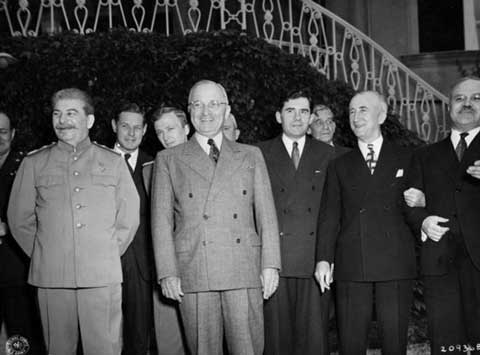
The Potsdam Conference, July 1945
Foolish is the politician who keeps a diary. Truman made that mistake (as did Nixon with his tapes). Truman's diary fuels Tokuda's lust for revenge. The tale it tells of how the president decided to drop the bomb doesn't mesh with the propaganda fed to a gullible public.
Tokuda grew rich from blackmarketing after the war. For long-distance revenge, he financed flooding America with street drugs. And the damage done to the U.S. by Japan's corrupt "bubble economy" in the 1980s and 90s? Genjo Tokuda was also behind that.
But now the kumicho's an old man with a hands-on promise to keep. He swore at the ruins of his ancestors' Hiroshima shrine that he would personally kill the airmen who actually dropped the bomb. Half a century of gang rivalries have kept him in Japan, until that time of life when he must tie up loose ends. Joe "Red" Hett coming to the Pacific War Vets' Convention is where he'll strike.

Japanese soldier using his katana sword
Losing a parent when you're young creates a driving need to know who that parent was. Slade wrote three novels around his quest to "find" his Dad: HEADHUNTER, SWASTIKA, and CRUCIFIED. Only with the death of his Mom in 2003 did Slade discover his Dad's war archive in the attic. What a treasure trove!
Genjo Tokuda's son has a similar need. Under the effect of morphine on her deathbed, Viv Barrow finally reveals who his father is. Life has not been good to Genjo Tokuda's son. And now he learns that he is heir not only to the samurai traditions inherent in the Kamikaze sword, but also to his "childless" father's yakuza wealth.
Under the code name "Kamikaze," the son contacts his father. When they meet in Vancouver to jointly avenge Hiroshima, he will prove that he's bushido-worthy of the sword.
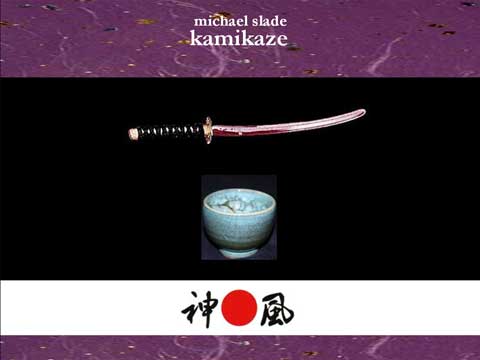
Genjo Tokuda arrives in Vancouver with a kamikaze pilot.


Genjo Tokuda arrives in Vancouver with his enforcer, the Claw. And with the Sushi Chef, who fillets more than fish.
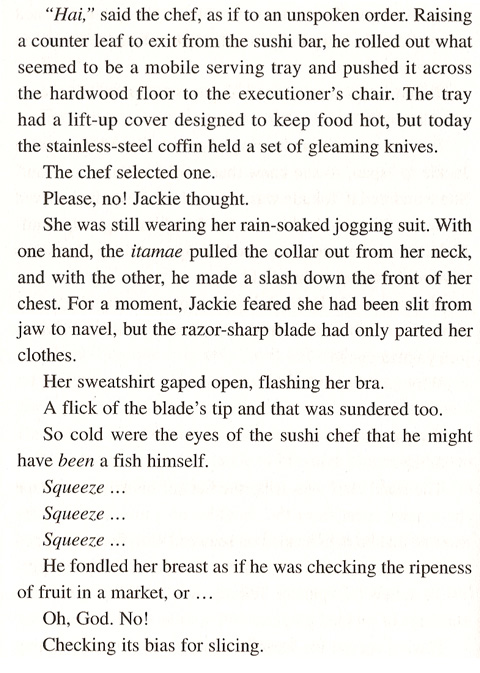

"When you are widely known as Canada's Master of the Macabre, it's really tough to break out of the mold. But Michael Slade has done that superbly with SWASTIKA and KAMIKAZE, each of them based on the wartime experiences of his parents in the European and Pacific conflicts. Both books are mainstream thrillers that zip along at the usual Slade pace, and both ring chillingly true and grotesquely familiar, dealing as they do with the repercussions of fact-based historical conspiracies in our world today. Art imitating life, or is it the other way around? Either way, we're seeing a virtuoso breakout by Slade into another realm of creativity." - Jack Whyte, author of the CAMULOD CHRONICLES, the TEMPLAR trilogy, and the GUARDIANS series
"KAMIKAZE interweaves the atrocities and conspiracies of the past with fast-paced contemporary action. The storytelling is crisp and seemingly effortless as it shifts between past and present. The storyline is compelling, and there are enough twists to satisfy even the most ardent Slade fan. An intense cat-and-mouse game plays out on the streets of Vancouver and in the skies above Lions Gate Bridge. With its strong emotional resonance, KAMIKAZE is a passionate indictment of the lies of wartime. It's intense, and easily capable of keeping a reader up into the wee hours." - THE VANCOUVER SUN
"KAMIKAZE is a deeply cynical piece of work. Slade pairs a string of murders in present-day Vancouver with historical events in the larger world. It's a given that the story lines will converge by novel's end. Several aspects are a treat, like the attentive depiction of place. Slade is all about procedure, feeding our endless appetite for the inner workings of the police. The novel's enormous research (learn the bomb's dimensions! the ritual of hara-kiri!) and central thesis make it something else. President Harry Truman's sanguine acceptance of bloodshed here is chilling, and war itself comes off as the most murderous of serial killers." - THE GEORGIA STRAIGHT
"From DISASTER ON MOUNT SLESSE: 'Some of the plane's control cables had wrapped around an outcrop near the peak. A piece of the aircraft's nose was tangled in the wires, prevented from falling down the precipice to where the remainder of the plane had come to rest. The tangle contained part of a man's body still clad in what appeared to be a TCA uniform. The whole mess dangled over the sheer face of the peak - surreal and horrifying, it was a sight that held the climbers spellbound.'"Michael Slade was nine years old when his father disappeared 16 days before Christmas. The boy grew up to be a writer as well as a lawyer, his childhood trauma perhaps informing the gruesome nature of the crimes in the popular thrillers he writes." - THE GLOBE AND MAIL
"Slade obviously believes that no war remains locked in the past, but instead extends tentacles into the present and beyond. No Slade novel would be complete without a psychopath or two. However, Slade also has some hidden agendas. He's not satisfied to merely present an intriguing whodunit that will have mystery lovers scratching their heads and sorting through enough red herrings to stock a fish hatchery - though he does. In KAMIKAZE, he postulates a controversial hidden motivation for the bombing of Hiroshima that doesn't appear in most history books.Complete with Slade's famous attention to detail and rigorous research, and his willingness to heap abuse and even death upon major characters, KAMIKAZE weaves together the historical strands of the narrative with contemporary tales of insane killers and the heroic feats of the Special X force in a gripping, tense, and exciting climax." - HELLNOTES
Every Slade novel is researched with the help of the Mounted Police. KAMIKAZE focuses on Special O, the surveillance experts of the RCMP. In discussing how they tail a suspect, one of the Mounties said, "The method used by most modern police forces is the same as that set out in THE HARDY BOYS' DETECTIVE HANDBOOK in the 1950s."
Slade checked his boyhood copy, still in his library, and there it was. If it ain't broke, don't fix it.
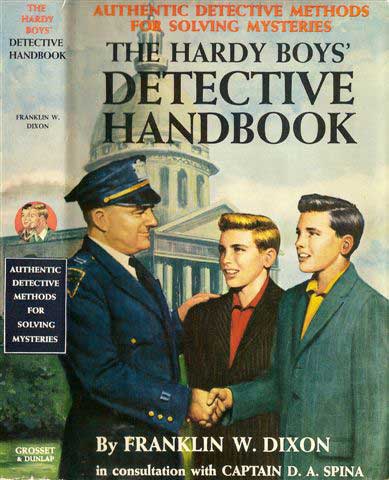
In the final days of his mother's life, Slade sat vigil by her bed. He thought she was unconscious when he held her gnarled hand and promised to see her reunited with his Dad. She gave his hand a squeeze...and then she was gone.
Slade had never been to Mount Slesse. He was too young to attend the memorial service at the base of the Fang - as it was known to the locals - in 1957. With 62 people killed in the crash, it was too highly charged an emotional ordeal for a nine-year-old boy.

At the foot of Mount Slesse, 1957
Slade's Mom was cremated at the end of May. Not until late in the summer would the avalanche danger be clear. First, Slade hired a helicopter and got permission to fly to the summit. Then - because his mother was of Scottish heritage (see BIO) - he required a piper.
It seemed unlikely that the Canadian military would provide a piper for the death of an 82-year-old woman. Nothing ventured, nothing gained, Slade made the call.
He told the story of how his Mom had lost her husband, and of how his Dad's uniform was desecrated by a trophy hunter who stole his wings and buttons, and of how the authorities buried his remains in a mass grave marked with a makeshift wooden cross, then kept it a secret. (See SWASTIKA)
"How many combat missions did he fly?" asked the piper.
"Forty-seven." (See CRUCIFIED)
"Then apart from your mother, you have unfinished business, sir."
Slade was impressed by the fellow who met him at dawn at the airport. Now that's a piper.
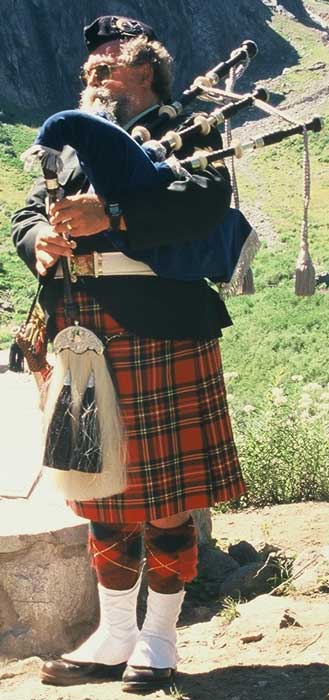
The Fraser Valley collects pollution that drifts inland from Vancouver. But on that morning, overnight winds had blown it clear. The Fraser River was molten gold all the way to Chilliwack, where the Chilliwack River branched south as a silver stream. At that point, the chopper climbed in around the shoulder of the Fang.

Slesse fronts the Cascade Mountains
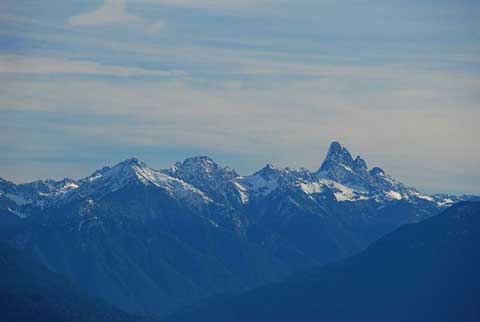
View from the Chilliwack River (licensed copyright)
The helicopter set down at close to 7,000 feet.
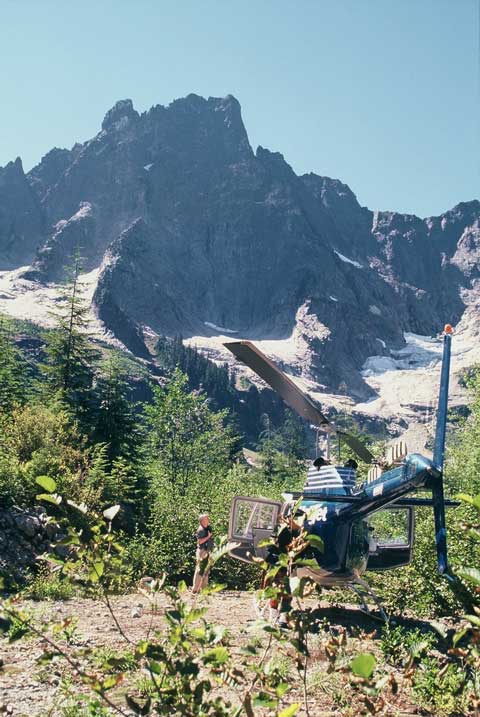
In addition to playing the pipes, the Scotsman was a bugler. Except for the chirps of nature - and there were few at that elevation - utter silence reigned. Though dominated by the Fang ("slesse" is the Coast Salish Natives' word for "fang"), the steep, bowl-shaped hollow - or cirque - was ringed by mountains.
For Slade's Dad, the bugler began with "The Last Post." He switched to the pipes for "Flowers of the Forest," the official lament of the Canadian Forces. The tune is only performed at funerals and memorial services.
It's said the bagpipes can be heard by the spirits of the dead. "Flowers of the Forest" calls them home. The unspoken words are:
I've heard the lilting, at the yowe-milking,Lassies a-lilting before dawn o' day;
But now they are moaning on ilka green loaning;
"The Flowers of the Forest are a' wede away."
A minute of absolute silence followed. Slade hadn't been this close to his father in almost fifty years. Then the bugler played "The Rouse." "Reveille" wakes soldiers up; "The Rouse" gets them out of bed.
To scatter his Mom's ashes, Slade found a clearing away from the crash gravesite. He opened the box with her cremains and removed the plastic bag. The image in his mind was of the photo above, the one with Viv holding her newborn son. Look at the smile on her face. Now, the wheel had come full circle, and he held her with tears in his eyes.
As Slade slit the bag with the Swiss Army knife she'd given him as a boy, the piper began to play "Amazing Grace" for his Mom. And that's when it happened...
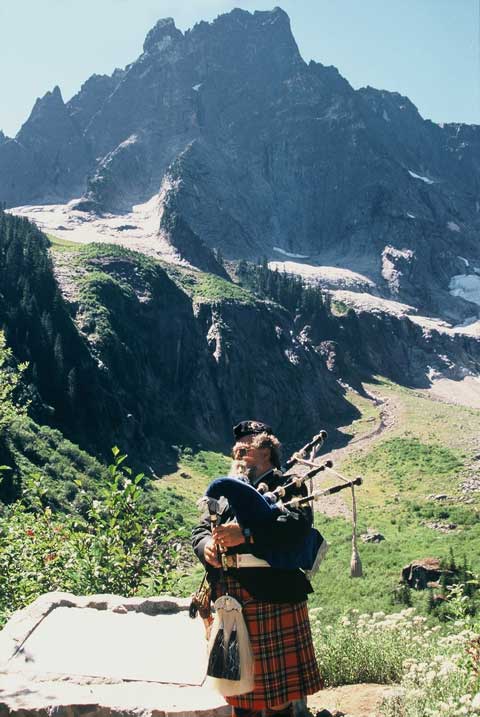
"Amazing Grace" echoes from the Fang
Perhaps it was a random breeze on a still day. Shifting air - subsidence - had helped kill Slade's Dad. Or perhaps it was a subconscious jerk of Slade's hand. Or - given the rarefied oxygen at that altitude - perhaps it was little more than a mirage-like hallucination through his tears. But whatever the cause, Viv's ashes blew out of Slade's hand at the first notes of "Amazing Grace."
It wasn't dramatic - a great cloud of dust - just a gentle puff that blew her toward the Fang.
"That's a song that gets to everybody," said gospel singer Marion Williams of "Amazing Grace." And because the tune is played loud, the wail of that single piper echoed off the surrounding peaks, sending Viv to join the love of her life with a full pipe band.
There's not a more awesome natural cathedral than a mountain cirque at 7,000 feet. The piper was in his element, so he gave Viv a send-off with all the tunes of glory.
On returning to the airport, Slade poured a dram of whisky into a pair of shot glasses. Then he locked arms with the Scotsman and snapped it back. That's called "paying the piper."
Nothing Slade's done in life has given him more satisfaction than laying Viv to rest on Slesse. Losing his father so young caused a disconnect in his mind. For almost half a century, he thought of his Mom and Dad separately. Now he thinks of them together.
We all die someday, and somehow we each find a final resting place. Jack's and Viv's can't be put better than this by reporter Paddy Sherman: "This is a place where I would gladly lie. The rock is clean and bereft of sadness, the deep quiet has a tranquillity all its own. At their heads, peaks reach for the sky in a sweep of stark grandeur, and the mountain itself is their monument."

Law has a concept called "the thin skull rule." In effect, "you must take your victim as you find him." If you negligently hit a man with your car and cause him brain damage, it's no defense to argue that he has an eggshell-thin skull, and that if he had a normal skull, he would not be injured.
The same applies to war. Who says your enemy must fight the way you do? If he fights according to the values of his culture, then you must take your enemy as you find him.
When the Romans invaded Britain, first they fought an enemy that burned people in wicker men. Then they fought Slade's ancestors, the headhunting Picts (see BURNT BONES). Later, when the British set out to colonize the world, they fought Zulu warriors who disemboweled their foes (see ZOMBIE/EVIL EYE), and South Pacific cannibals who ate theirs (see BED OF NAILS).
After the Twin Towers fell on September 11, news reports decried the barbarity of an un-Western enemy that used suicide as a weapon. Slade saw nothing new in kamikaze attacks, and recalled what President Truman said: "If you can't stand the heat, get out of the kitchen."
History is a timeline of cause and effect. Boiled down to basics, one could theorize this.
The plot in KAMIKAZE allowed Truman to threaten the Soviets with the killing potential of the atomic bomb. The plot in SWASTIKA gave the Pentagon a nuclear missile that could strike Russia. That spawned the Arms Race and the Cold War. The Cold War spread American and Soviet troops around the world. The fall of the Soviet Union drew the Russians home. The Americans stayed put to protect stategic interests, like oil. Infidel boots defiling the sands near holy Mecca enraged Osama bin Laden. To strike back at the Americans through terrorism, al-Qaeda kamikaze planes attacked New York. That provoked the wars in Afghanistan and Iraq, which led to the constant threat of suicide bombers today...
On one level, KAMIKAZE is a revenge thriller driven by World War II.
On a deeper level, it's about something else.
And since the book was published in 2006, that subtext has played out again...and again...and again...
